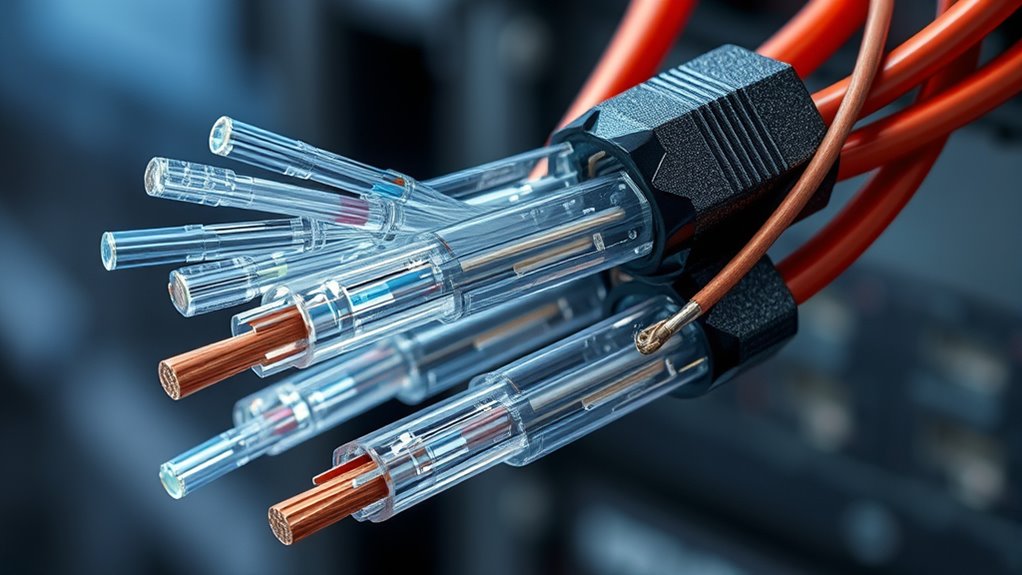Just as a master architect combines different materials for a stronger structure, integrating fiber and copper in a single cable can revolutionize your network setup. These hybrid cables are designed to support both high-speed data transfer and reliable power delivery, making them versatile for modern needs. But how exactly do they simplify installation and future-proof your infrastructure? Exploring their capabilities might just change the way you think about network design.
Key Takeaways
- Combine fiber optic strands with copper wiring for simultaneous high-speed data transfer and reliable PoE power delivery.
- Support long-distance data transmission with minimal interference, ensuring network stability.
- Simplify infrastructure by integrating power and data in a single cable, reducing installation time and costs.
- Enhance durability and future-proofing, accommodating higher data speeds and power needs over time.
- Suitable for diverse environments, including outdoor, multi-floor, or sprawling network setups.

Hybrid fiber-copper cables for Power over Ethernet (PoE) are becoming an increasingly popular choice for delivering reliable network power and data simultaneously. These cables combine the high-speed capabilities of fiber optic strands with traditional copper wiring, enabling you to harness the best of both worlds. If you’re aiming for a robust, flexible solution that supports high bandwidth and reliable power delivery, hybrid cables are worth considering. The fiber optic component allows for fast, long-distance data transmission with minimal interference, making them ideal for large-scale or complex network setups. Meanwhile, the copper part handles the power over Ethernet, supplying electricity directly to devices like IP cameras, wireless access points, or VoIP phones without needing separate power supplies or outlets. This hybrid arrangement simplifies installation, reduces clutter, and cuts costs by eliminating the need for additional infrastructure.
When you choose hybrid fiber-copper cables for PoE, you’re leveraging fiber optic technology’s inherent advantages. Fiber optics can transmit data over much longer distances without signal degradation, so you don’t have to worry about losing performance as your network extends across your premises. This is particularly useful if your setup involves multiple floors, outdoor environments, or sprawling campuses. The fiber ensures that your data stays fast and reliable, regardless of distance. On the other hand, the copper wiring within the cable provides the power over easy-to-access points, delivering the necessary electricity to devices directly through standard Ethernet ports. This dual functionality means less equipment, fewer connections, and a cleaner, more efficient network infrastructure.
You also benefit from the durability and future-proofing of hybrid cables. Fiber optic strands are less susceptible to electromagnetic interference, which can be a problem in industrial or electromagnetic-rich environments. This resilience guarantees your network remains stable and secure. Plus, as technology advances, hybrid cables can accommodate higher data rates and power requirements, ensuring your network can grow with your needs. Installing these cables might seem complex at first, but their design simplifies integration into existing systems. You can run fiber optic and copper components through the same conduit, reducing installation time and costs. The combination offers a flexible, scalable, and reliable solution for diverse networking environments.
Frequently Asked Questions
How Do Hybrid Cables Compare in Cost to Traditional Cables?
You’ll find hybrid cables generally cost more upfront than traditional cables due to their advanced technology, but they can save you money in the long run. The cost comparison shows that installation expenses might be higher initially because of their complexity, but they often reduce ongoing maintenance and upgrade costs. Overall, investing in hybrid fiber-copper cables can be more economical over time, especially for high-performance network needs.
Are Hybrid Fiber-Copper Cables Environmentally Friendly?
You might wonder if hybrid fiber-copper cables are environmentally friendly. They generally have a lower environmental impact because they use materials that balance performance with sustainability. By reducing material waste and energy consumption during manufacturing, these cables support greener practices. Their design promotes material sustainability, making them a smarter choice for eco-conscious installations. While not perfect, hybrid cables offer a more environmentally friendly option, helping you minimize your carbon footprint without sacrificing quality.
What Are the Maintenance Requirements for Hybrid Cables?
You should regularly inspect connector durability to guarantee optimal performance, checking for corrosion or damage. Follow proper installation procedures to prevent strain or misalignment, which can affect cable longevity. Keep cables clean and avoid excessive bends or pulling during maintenance. Periodically test signal quality and replace connectors if you notice issues. Proper handling and routine checks help maintain hybrid cables’ reliability and extend their lifespan.
Can Hybrid Cables Be Used Outdoors in Harsh Environments?
Don’t judge a book by its cover, especially when it comes to outdoor durability. You can use hybrid cables outdoors in harsh environments, provided they’re designed for environmental resilience. These cables are built to withstand extreme temperatures, moisture, and UV exposure. Just make certain you select those rated for outdoor use and follow proper installation guidelines. With the right choice, hybrid cables can perform reliably, even in the toughest conditions.
How Do Hybrid Cables Impact Overall Network Scalability?
Hybrid cables substantially boost your network scalability benefits by enabling easier network expansion. They allow you to upgrade or extend your system without replacing existing infrastructure, saving time and costs. With hybrid cables, you can support higher data rates and longer distances, ensuring your network adapts seamlessly to future needs. This flexible approach helps you grow your network efficiently, accommodating increased device demands and new technologies as your organization evolves.
Conclusion
In concise terms, hybrid fiber-copper cables gently open the door to a more streamlined and adaptable network setup. They subtly enhance your infrastructure, blending the best of both worlds without overwhelming your space. As technology continues to evolve, choosing these versatile cables can quietly future-proof your system, ensuring reliable power and data flow. Embrace this innovative solution, and you’ll find your network effortlessly ready for whatever comes next.









